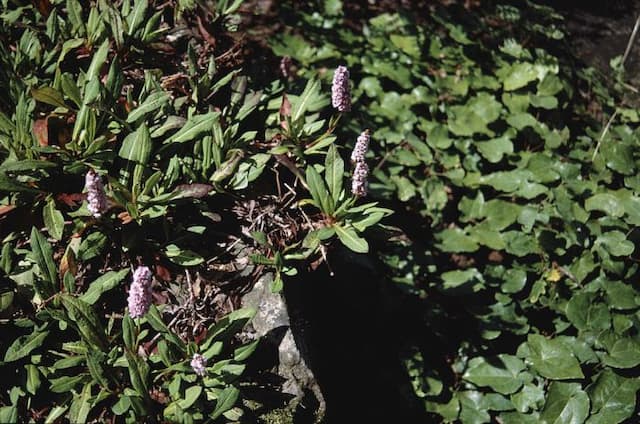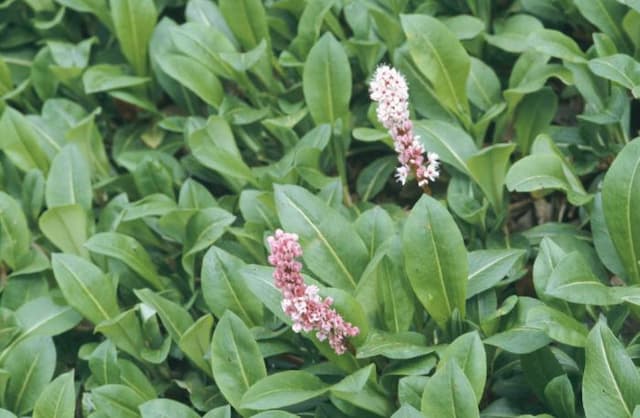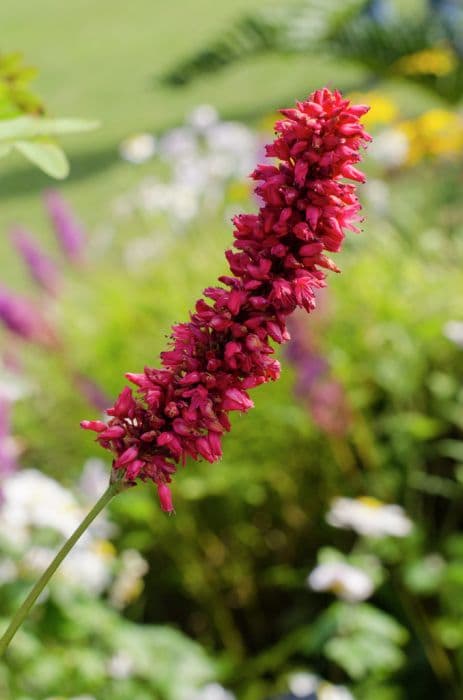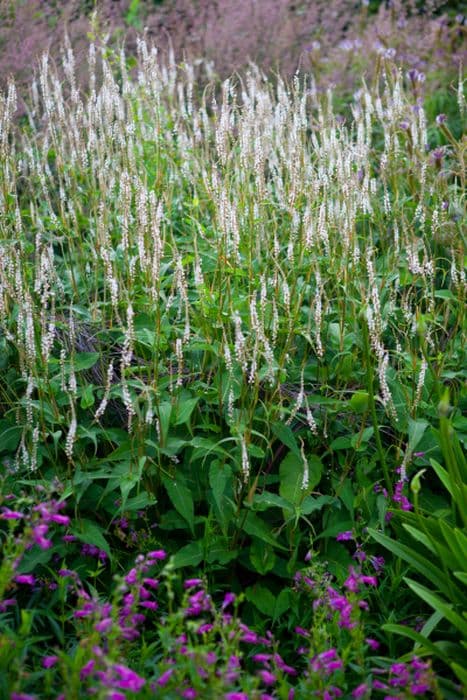Virginia Knotweed Persicaria virginiana var. filiformis 'Compton's Red'

ABOUT
Compton's Red is a strikingly attractive plant known for its vibrant foliage and unique floral characteristics. The leaves are particularly eye-catching, with a deep green base color marked by intricate patterns. The foliage oftentimes features a central area painted in a burgundy or deep red hue, creating a dramatic contrast with the green. This variegation adds depth and visual interest to a garden display. The leaves are also textured, giving the foliage a rich, tactile quality. In addition to its compelling foliage, it offers an array of slender, wand-like spikes that stand above the leaves. These spikes carry clusters of tiny, star-shaped flowers. The flowers are commonly a subtle whitish or pinkish hue, adding a light, airy touch to the visual composition of the plant. They typically bloom in the late summer to early fall, providing a seasonal display of color and form. The overall appearance of Compton's Red is one of lushness and vibrant contrast, with a form that adds structure and a sense of movement to garden landscapes. It is known for being an engaging presence in a variety of garden settings, notable for its decorative leaves and distinctive flowering spikes.
About this plant
 Names
NamesFamily
Polygonaceae
Synonyms
Virginia Knotweed, Jumpseed, Woodland Knotweed, Variegated Virgin's Bower
Common names
Tovara virginiana var. filiformis, Polygonum virginianum var. filiforme
 Toxicity
ToxicityTo humans
The plant commonly known as Virginia knotweed typically is not known to be toxic to humans. There is limited evidence of its consumption, but it does not generally appear on lists of poisonous plants. Therefore, no specific symptoms of poisoning are commonly recognized. However, as with any plant, individual allergies or sensitivities could occur, making it inadvisable to ingest this or any plant not commonly recognized as food.
To pets
Virginia knotweed is not commonly known to be toxic to pets such as dogs and cats. Since information specific to this variety is not widely documented, it is prudent to prevent pets from ingesting this or any plant not specifically intended for them. If a pet does ingest Virginia knotweed and shows symptoms of distress, it is advisable to contact a veterinarian. Symptoms could include vomiting, diarrhea, or abnormal behavior, but these are not specifically linked to this plant.
 Characteristics
CharacteristicsLife cycle
Perennials
Foliage type
Deciduous
Color of leaves
Variegated
Flower color
White
Height
2-3 feet (60-90 cm)
Spread
2-3 feet (60-90 cm)
Plant type
Herb
Hardiness zones
5
Native area
North America
Benefits
 General Benefits
General Benefits- Attracts Wildlife: Persicaria virginiana 'Compton's Red', commonly known as Jumpseed, draws beneficial insects, butterflies, and birds to the garden, providing a source of food and habitat for them.
- Erosion Control: The plant's root system helps stabilize soil on slopes or areas prone to erosion, preventing the loss of soil during heavy rains.
- Aesthetic Appeal: With its attractive foliage and reddish-pink floral spikes, Jumpseed adds visual interest and color to garden beds or landscapes, enhancing the overall beauty of the area.
- Low Maintenance: Jumpseed is known for being easy to care for, requiring minimal upkeep once established, making it suitable for gardeners of all experience levels.
- Shade Tolerance: The plant thrives in shaded conditions where other plants might struggle, providing gardeners with an option for beautifying less sunny spots.
- Versatility: It can be used in a variety of garden designs, including woodland gardens, naturalized areas, and as a border plant, due to its adaptable nature.
- Drought Resistance: Once established, Jumpseed is relatively drought-tolerant, making it an ideal choice for gardens in drier climates or for water-wise landscaping.
 Medical Properties
Medical PropertiesThis plant is not used for medical purposes.
 Air-purifying Qualities
Air-purifying QualitiesThis plant is not specifically known for air purifying qualities.
 Other Uses
Other Uses- Jumpstarters for Compost: The leaves of Persicaria virginiana can be added to compost piles as a green layer, providing nitrogen and helping to balance carbon-rich materials.
- Erosion Control: Its dense foliage and spreading habit make it an effective plant for controlling erosion on slopes or banks.
- Wildlife Habitat: The dense growth of Persicaria virginiana provides cover for small wildlife and nesting material for birds.
- Natural Dye: The roots and stems may be used to produce a natural dye for coloring fabrics or yarns, though this use is more experimental than established.
- Educational Tool: Schools and botanical gardens might utilize this plant to teach about native species and biodiversity in garden ecosystems.
- Artistic Inspiration: Artists may use the dramatic red hues of 'Compton's Red' as a live model for painting or photography.
- Culinary Garnish: While not commonly consumed, the colorful leaves can be used as a decorative garnish for upscale culinary dishes.
- Garden Design: Its distinct foliage provides textural contrast when used in shade garden designs, aiding in aesthetic plant compositions.
- Craft Supplies: The strong stems can be dried and used in floral arrangements or other decorative crafts.
- Pond Edges Stabilization: It can be planted near the edges of ponds to help stabilize the soil and provide a naturalistic border.
Interesting Facts
 Feng Shui
Feng ShuiThe Virginia knotweed is not used in Feng Shui practice.
 Zodiac Sign Compitability
Zodiac Sign CompitabilityThe Virginia knotweed is not used in astrology practice.
 Plant Symbolism
Plant Symbolism- Adaptability - Persicaria virginiana, commonly known as Virginia knotweed, often thrives in various conditions and soil types, symbolizing the ability to adapt to different environments and situations.
- Resilience - Virginia knotweed is a plant that can rebound and grow even after experiencing disturbances or adverse conditions, representing the trait of resilience in the face of challenges.
- Connection - The intricate network of roots that Virginia knotweed develops symbolizes the interconnectedness of all things and the importance of establishing strong foundations and relationships.
 Water
WaterJumpseed typically requires even moisture and should be watered when the top inch of soil feels dry to the touch. Aim for consistent watering intervals, providing roughly an inch of water weekly, but be prepared to water more frequently during hot, dry periods. It is essential not to let the soil become waterlogged, so ensure adequate drainage. Depending on conditions, this can mean watering every few days to once a week, using a gentle pour around the base to avoid splashing the foliage, using approximately half a gallon per watering session for a medium-sized plant.
 Light
LightJumpseed thrives best in partial shade where it receives some sunlight but is also protected from the harsh midday sun. Ideal conditions would be a spot that gets dappled sunlight throughout the day or bright indirect light. However, it can also adapt to full shade, making it quite versatile for different garden locations. Avoid placing Jumpseed in full sun as it may scorch the leaves.
 Temperature
TemperatureJumpseed is hardy in USDA zones 4 to 8, tolerating a temperature range from around -30 to 100 degrees Fahrenheit. The ideal temperature for this plant is between 60 to 75 degrees Fahrenheit. These adaptable perennials can survive some temperature fluctuations, but extreme cold or heat for prolonged periods can be detrimental.
 Pruning
PruningFor Jumpseed, pruning is mainly done to shape the plant, encourage bushier growth, and remove any spent flowers or damaged foliage. The best time to prune is in late winter or early spring before new growth starts. It may need additional light trimming throughout the growing season to maintain its form. Pruning once a year is generally sufficient, but light maintenance can be done as needed.
 Cleaning
CleaningAs needed
 Soil
SoilVirginia Jumpseed prefers a well-draining soil mix, high in organic matter, such as a blend of loam, peat, and coarse sand. The soil pH should be moderately acidic to neutral, ranging from 5.5 to 7.0, to accommodate its growth requirements optimally.
 Repotting
RepottingVirginia Jumpseed typically does not require frequent repotting and can be repotted once every 2 to 3 years, or when it outgrows its current container.
 Humidity & Misting
Humidity & MistingVirginia Jumpseed thrives best in moderate humidity levels, but it is quite adaptable and can tolerate a range of humidity conditions present in typical garden environments.
 Suitable locations
Suitable locationsIndoor
Use well-draining soil; place in bright, indirect light.
Outdoor
Plant in partial shade, moist, well-drained soil.
Hardiness zone
4-8 USDA
 Life cycle
Life cyclePersicaria virginiana var. filiformis 'Compton's Red', commonly known as Virginia knotweed or jumpseed, starts its life cycle from seeds which germinate in spring, given moist soil conditions and adequate light. The seedlings develop into mature plants with distinctive red-marked foliage and a spreading habit through rhizomatous growth, typically reaching their mature size within one growing season. During late summer to early autumn, the plants produce spikes of tiny, white or pinkish flowers, which are often considered inconspicuous compared to the foliage. After pollination, these flowers develop into small, black fruits that contain the seeds, completing the plant’s reproductive cycle. Throughout the winter or during unfavorable conditions, the plant's above-ground growth dies back, while the roots (rhizomes) survive underground to regenerate the next spring, ensuring the plant's perennial nature. Over time, without control measures, Virginia knotweed can spread and form dense clumps, potentially outcompeting nearby plants.
 Propogation
PropogationPropogation time
Spring-Early Summer
Propogation: Virginia knotweed 'Compton's Red' is generally propagated through division, which is best done in the spring or early fall. To propagate by division, dig up an established clump of the plant and gently separate the roots into smaller sections, each section containing several shoots and a healthy chunk of root system. These divided sections can then be replanted in a prepared bed or potting mix, spaced about 18 to 24 inches (approximately 45 to 60 centimeters) apart, to give them ample room to grow. It's important to keep the newly planted divisions well-watered until they are established. This method leverages the plant's natural growth and tendency to spread, making division a popular and effective means of propagation for this particular species.






![Red bistort [Taurus]](/_next/image?url=https%3A%2F%2Fplants-admin.emdemapps.com%2Fimages%2Fplants%2F%2Fimages%2F604b548be7841.png&w=640&q=75)


